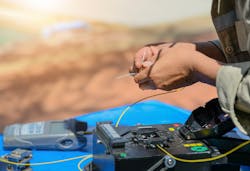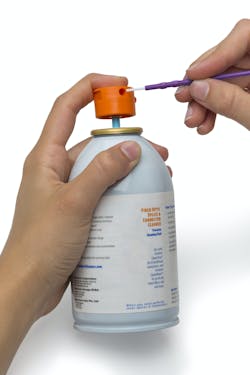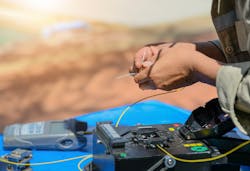Fiber cleaning leads to successful fiber blowing operations
The fiber-optic industry has seen significant advancements in recent years, particularly in the use of microcables and the fiber blowing process. Microcables, also referred to as microducts, are small, flexible tubes designed to encase and safeguard fiber-optic cables within confined spaces, such as conduits or ductwork. Fiber blowing is a state-of-the-art method that uses compressed air to facilitate the installation, or blowing of the fiber-optic cables into these microducts.
These innovations have fueled a substantial increase in the size and importance of microcables and fiber blowing processes, with the global cable blowing equipment market projected to grow from USD 105 million in 2022 to USD 133 million by 2027, demonstrating a compound annual growth rate (CAGR) of 4.8% during this forecast period, according to a recent Markets and Markets forecast. This growth is attributed to the escalating demand for high-speed internet connectivity and the surge in data traffic driven by technologies like 5G and IoT. Blown optical fiber systems provide improved network reliability and stability and are used by several industries, from telecommunications to healthcare and transport.
One of the distinctive advantages of blown optical fiber systems, which encompass both microcables and fiber blowing processes, is their ability to upgrade and expand networks without causing significant disruption. Traditional methods of fiber-optic cable installation can be time-consuming and labor-intensive. In contrast, fiber blowing offers a highly efficient and cost-effective alternative, making deployment quicker and reducing operational costs. For these reasons, fiber blowing techniques are emerging as an optimal method of rapidly deploying networks, enabling providers to deliver high-speed internet services to a broader customer base more efficiently.
Contamination issues
Although blown optical fiber systems are helping to expand more reliable networks more quickly, one crucial element to reliability that cannot be overlooked is the importance of cleaning fiber-optic connections like splices and endfaces. For some cable installers, cleaning may not always be the focus, but it plays a vital role in ensuring the reliability and performance of fiber-optic networks.
Fiber splices are the points where two fiber-optic cables join. These splices can become contaminated with dirt, dust, and other debris, causing signal loss or even complete network failure. To prevent this, it is essential to maintain the integrity of the splices by cleaning them thoroughly using specialized fiber-optic cleaning tools.
Similarly, the endfaces of fiber-optic cable connections can also become contaminated during the installation process. This can occur when the endfaces are handled or contact other surfaces. Contaminants such as oil, dust, and fingerprints can interrupt signal transmission through the cable, leading to signal disruption and latency.
Fiber-optic connections are also sensitive to moisture, and fiber blowing can create moisture in the duct or conduit, leading to signal loss. To prevent this, it is important to use clean, dry air during the fiber blowing process and to inspect the cables carefully for any signs of contamination before and after installation. Remove any moisture through careful cleaning.
Static electricity is another challenge when it comes to fiber blowing. The process can create static, which often makes dust contamination worse. An electrostatic charge on a connector attracts airborne particulate and locks it onto the connector endface. The condition gets worse in dry, low-humidity conditions, which can exacerbate contamination by drawing dust and debris onto the endfaces. Wet-to-dry endface cleaning is recommended to combat static.
Effectively cleaning blown fiber installations
A systematic and thorough approach is required to achieve effective cleaning of blown fiber installations. Key steps should include the following.
Assessment
Before commencing the cleaning process, a comprehensive assessment of the fiber-optic installation is essential. This assessment involves a detailed visual inspection of various components, including microducts, connectors, and fiber ends. The goal is to identify areas requiring cleaning and assess the extent of contamination.
Preparing cleaning tools
The next step involves gathering the required cleaning tools and supplies. These include those specifically engineered for fiber connector cleaning and typically include:
- Lint-free wipes
- Optical-grade, fast-drying, static-dissipative cleaning fluid
- Single-use connector cleaning tools like cleaning sticks and mechanical click-to-clean tools
- Fiber optic inspection scope
Cleaning connectors
Knowing how to use all these fiber cleaning tools correctly is essential. If used incorrectly, they can cause more harm than good. Every fiber-optic technician should know the “inspect, clean, inspect” cleaning technique. First, inspect the endfaces before cleaning to identify the type and amount of contamination. By understanding the contamination, it helps technicians determine which cleaning technique and tools are appropriate to remove it.
Next, wet/dry clean the fiber endfaces with an engineered fiber cleaning fluid to remove contaminants. The engineered cleaning fluid is used in tandem with other cleaning tools including lint-free wipes, cleaning sticks and mechanical click-to-clean tools.
Cleaning microducts
If the microducts themselves appear dirty or contaminated, use dry air to remove loose debris. For stubborn contaminants, lint-free cleaning sticks can be employed. It is imperative to ensure that the air used is clean and dry to prevent further contamination.
Inspecting and verifying cleanliness
Finally, after cleaning, conduct a meticulous visual inspection of connectors and microducts to ensure they are completely free from contaminants. Use fiber-optic inspection tools to examine endfaces for scratches, dirt, or residue. This step is crucial for verifying compliance with the International Electrotechnical Commission (IEC) 61300-3-35 cleanliness standard.
Documentation and maintenance
To maintain a high level of network cleanliness and performance, it is essential to maintain proper documentation of cleaning procedures. Records should include the dates of cleaning, the individuals responsible, and any observations or issues detected during the cleaning process. Regularly scheduled cleaning and inspection procedures are vital for ongoing network reliability.
Optimal wet-to-dry cleaning techniques
The wet-to-dry cleaning method is a highly effective approach in all fiber cleaning, including blown fiber installations. It plays a crucial role in eliminating static charges and ensuring the removal of contaminants from fiber endfaces. This method's significance becomes even more apparent when considering the unique challenges that blown fiber systems pose.
Wipes: Always opt for high-quality optical-grade wipes designed to meet stringent cleaning standards. These wipes are engineered to minimize lint and static charge generation during cleaning. When executing wet-to-dry cleaning with a wipe, moisten a section of the optical-grade cleaning wipe using a specialized static-dissipative cleaning fluid.
Gently wipe the connector endface, starting from the dampened area of the wipe towards the dry portion. This will effectively eliminate contamination while simultaneously mitigating static charge buildup.
To further ensure the cleanliness and effectiveness of these wipes, it is advisable to leave them in their packaging until ready for use. Additionally, the disposable nature of these wipes prevents cross-contamination. They should be discarded after a single use to maintain optimal cleanliness standards.
Cleaning stick: Cleaning sticks should have polymer-tipped ends, so they do not lint like paper, cotton, or foam swabs. The cleaning stick is particularly suitable for heavily soiled connectors or connectors mounted in hard-to-clean alignment sleeves. The wet-to-dry process begins by moistening the stick with cleaning fluid, not oversaturating the tip. Then insert the stick into the connector and rotate about six times in one direction to remove contamination. Avoid vigorous scrubbing or excessive force to prevent potential damage such as scratching, pitting, or scarring of the endfaces. It is important to note that to prevent cross-contamination, it is essential to use one stick per endface.
Mechanical click-to-clean tools: Mechanical clicker tools offer a quick and efficient solution for addressing lighter contamination levels. When employing the wet-to-dry method, a technician initiates by applying a small amount of cleaning fluid to an optical-grade wipe, avoiding direct application to the click-to-clean tool. The clicker tool's tip is then gently pressed into the moistened section of the wipe. Next, the tool is inserted into the endface for a rapid, one-click cleaning process.
Choosing the right cleaning fluid: Selecting the appropriate cleaning fluid is critical for effective wet-to-dry cleaning. Isopropyl alcohol (IPA) and water are not recommended due to challenges in maintaining purity and slow drying times. Instead, optical-grade cleaning fluids specifically engineered for fiber-optic cleaning should be used. These fluids are non-flammable, non-hazardous, and dispensed from hermetically sealed containers to prevent contamination.
Cleaning for connectivity
The growing demand for high-bandwidth connectivity drives the rapid expansion of blown fiber optics. However, optimal performance requires careful fiber inspection, cleaning, and verification procedures. Technicians can effectively eliminate contaminants from critical connections by using specific fiber-optic engineered tools and techniques. The wet-to-dry cleaning method will ensure thorough contaminant removal. By implementing diligent protocols and proper execution, cleanliness can be maintained in blown fiber-optic deployments.
About the Author
Rick Hoffman
Rick Hoffman is commercial sales manager for the Sticklers™ Fiber Group, a division of MicroCare™. He has more than twenty years of fiber optic network training and sales experience. For more information, visit www.microcare.com.



